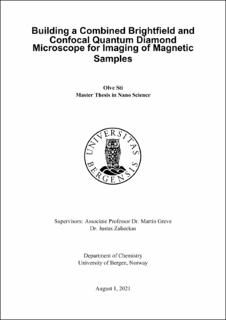Building a Combined Brightfield and Confocal Quantum Diamond Microscope for Imaging of Magnetic Samples
Master thesis
Permanent lenke
https://hdl.handle.net/11250/2773597Utgivelsesdato
2021-08-02Metadata
Vis full innførselSamlinger
- Master theses [85]
Sammendrag
The imaging of weak magnetic fields has been an important area of both research and technology. It continues to be an area that requires further research due to its potential wealth of applications. One magnetic field imaging technique that has risen in popularity these last few years is called a Quantum Diamond Microscope (QDM). The QDM uses the fluorescence from negatively charged Nitrogen Vacancy defect centers (NV) in diamond to image magnetic fields due to their usability at room temperature and pressure and high sensitivity to magnetic fields. NVs are fluoresced with a lowpower ∼594 nm laser, the NVs can also change into a dark, non-fluorescing, state, where they can remain on a timescale of several seconds. The change of state can be exploited to switch the fluorescence of NVs off, in a stochastic manner, and it will look as if they are blinking. Combining the NVs’ blinking together with their sensitivity to magnetic fields allow them to be used as sensors capable of imaging magnetic fields with super resolution. The objective of this Master Thesis is to build a microscope capable of performing Optically Detected Magnetic Resonance (ODMR) on NVcenters. Furthermore, the microscope will be used to carry out Stochastic Optical Reconstruction Microscopy (STORM) to obtain super resolution by exploiting the switching of NV to its dark state. The final goal is to combine the two and attempt to do super resolution magnetic field imaging. The main part of this thesis work involve the building of a combined bright-field and confocal microscope. To carry out STORM, a very sensitive photodetector must be implemented. For this purpose, both a Photomultiplier Tube (PMT) and a Si amplified photodetector was tested. Furthermore, the confocal pinhole must be optimized and aligned and a XYZ-piezo stage was installed for doing Confocal Laser Scanning Microscopy (CLSM). A LabVIEW program was developed to perform CLSM, and other programs in both LabVIEW and MATLAB were modified and implemented for the setup. For the confocal imaging, the focused laser spot on the sample was calculated to be 1460±30 nm and the number of NVs in the focused volumes of the two diamond samples used in this work were estimated to be 2400 NVs and 12 NVs. Confocal imaging has been demonstrated and the B field has been measured for 6 different ODMR measurements. Unfortunately it was not possible to demonstrate the blinking of NVs and further carry out STORM. It was found the PMT and Si amplified photodetector used had too much inherent noise to observe the NV blinking. It is suggested that a more sensitive detector like a photon counter detector is necessary to observe this.
